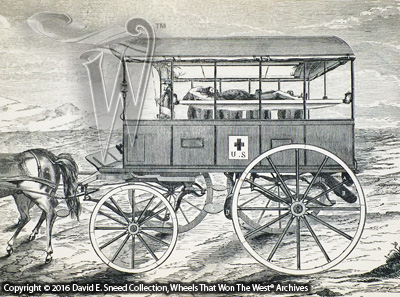Among early vehicle enthusiasts, there’sno shortage of discussions related to period military Escort Wagons as well as6-Mule or even 4-Mule Army Wagons. Lesstalked about, though, are the dozens of other early military transports such asLance, Lumber, Battery, Balloon, Abutment, Telegraph, Trestle, Forge, Tool Wagonsand more. Another seldom-coveredessential vehicle dating to America’s horse-drawn military era is the Ambulance. With origins in a multiplicity of uses,including as a stage and officer’s wagon, there is still a lot to be uncoveredabout this particular design.
 |
| This rare illustration dates to 1868 and shows one view of an ambulance designed by Thomas Evans. It’s from an original promotional booklet in our collection and held in the Wheels That Won The West® Archives. |
It’s been close to a century since thelegendary Studebaker Bros. Company sent horse-drawn military vehicles into thefield. From heavy army wagons to lightcarts and artillery pieces, the company created a host of vehicle types for useby the military. To that point, not longago, I ran across an 1898 article referencing “Rucker” ambulances thatStudebaker was building for the Spanish-American War. Originally designed by Brigadier General D.H.Rucker, the layout came into use during the latter part of the Civil War. This week, I thought I’d pass along a part ofthat story from the well-known, early trade publication called, “The Hub.”
“The half-toneillustration herewith represents one of six train loads of United StatesGovernment ambulances, built by Studebaker Bros. Manufacturing Co., South Bend,Ind. This company has received ordersfor 500 of these ambulances since the outbreak of hostilities with Spain, andup to the present time they have shipped 316; 50 are to be delivered weekly until the order is filled. These are known as the Rucker ambulance. The sides are composed of three white duckcurtains which may be rolled up if desired. Under the front end of the wagon and extending the full width of it is awater tank 16 x 9 inches. The inside ofthe body is fitted out to accommodate six persons. Two adjustable partitions are made to fit inthe bottom, which may be taken out when not in use. Each of these partitions is capable ofaccommodating one person. Two swings aresuspended from the top, leaving room for two bodies to be placed above the lowerpartitions. The wagons will be finishedin natural wood. In addition to theambulances, the Studebaker Co. received orders for 1,000 army wagons, 500 ofwhich have been delivered and the remaining 500 are underway…”
 |
| This late-1890’s photo shows dozens of Rucker-style ambulances leaving the Studebaker factory in South Bend. |
As with virtually every aspect ofAmerica’s first transportation industry, the subject of early ambulances ismore complex than many realize. Ambulance styles were varied and included numerous designs like theRucker, Wheeling, Coolidge, Moses, and Tripler patterns as well as others, suchas Thomas Evan’s 1868 concept shown in the first image above. Some designs received additional credentials asfound in the 1865 patent awarded to Benjamin Howard. While certain layouts might be similar,others differed by a host of considerations including interior features, bodysize, weight, spring configurations, and overall functionality concerns – suchas the ability of the front wheels to turn under the body of the vehicle.
If this week’s blog has whetted yourappetite for more information, you’re in luck. In 2004, the Carriage Museum of America published a detailed book on thesubject of horse-drawn military, civilian, and veterinary ambulances. If it’s not part of your library, I’drecommend it. It’s full of informationand you can still find it on-line from a number of sources.
Please Note: As with each of our blog writings, all imagery and text is copyrighted with All Rights Reserved. The material may not be broadcast, published, rewritten, or redistributed without prior written permission from David E. Sneed, Wheels That Won The West® Archives.
